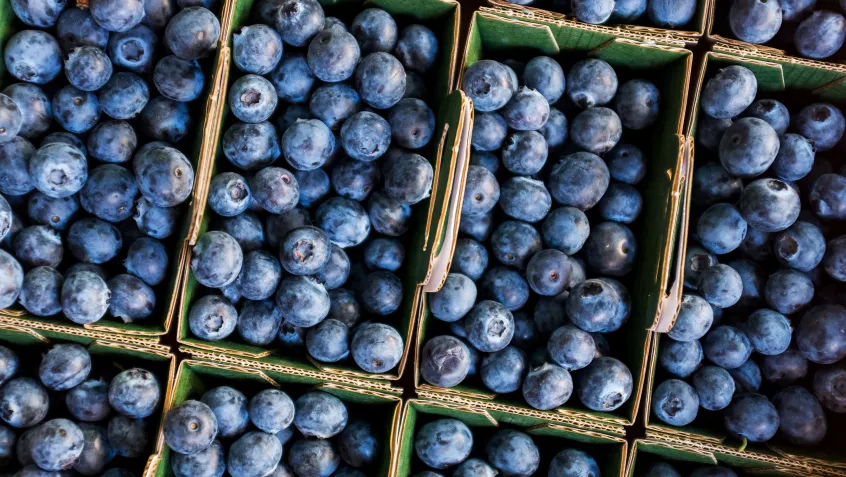
Read the updated version of this story.
Before you head to the market this week, check the weather! Weather and climate conditions play a big role in the production of summer produce, affecting the taste, size, and quantity of fruits and vegetables available during the warmer months.
The US produces a lot of blueberries—about 613 million pounds of this native fruit were harvested in 2018 alone. Within the United States, cultivated blueberries predominantly come from Washington, Oregon, Georgia, Michigan, and California, with most of the wild production occurring in Maine. These berries are weather-dependent, but their crucial time is way before the summer days where they appear in your local market. In the fall and winter, blueberries require about 1,000 “chill hours,” or time with temperatures below 45°F but still above freezing. The berries themselves will not grow until this requirement has been fulfilled, so an unusually warm winter can throw berry season into disarray. Another time the weather can throw a wrench into blueberry production is during the pollination period—unusually cold, wet, and windy weather at this time can inhibit pollination.
The United States is the second-largest producer of tomatoes in the world, growing tomatoes that will make their way across the world for both fresh and processed purposes. While tomatoes are produced in every US state, if you're buying fresh tomatoes at the market in the United States, it's likely that they're coming from either Florida or California, which routinely contribute two-thirds to three-fourths of all commercially produced fresh-market tomatoes in the country. However, while these two ends of the nation are traditionally the heavy-hitters, your best bet for price is going to be in August due to the availability of local tomatoes in your region. Although these seasonal snacks come in all shapes, sizes, and colors, they all thrive in weather with temperatures between 79 and 85°F during the days, and 65-70° at night during their summer growing period. If there's a cold snap during these traditional warm months, or a scorcher that brings the average temperatures out of this range, the fruit set (the size of the fruit) and the taste and overall quality can be negatively impacted.
A true summer staple, fresh sweet corn seems to find its way to the table throughout the warm months, whether cut into individual kernels or eaten straight from the cob. Of the more than two billion pounds of sweet corn produced each year in the United States, the majority is grown in California and Florida, with significant contributions from Georgia and Washington. This veggie needs lots of water, using about a quarter of an inch of water per day during periods of rapid growth. If the area where the corn is growing experiences water stress, or if the temperatures are high enough that too much moisture is being wicked out of the soil and the plants through evapotranspiration, fewer ears of corn may develop, and those that do emerge may be underformed. To avoid getting a bad ear at the market, look for corn with fresh green husks and soft, golden silk. The silk-ends should not have any signs of decay, and the kernels should look moist, plump, and bright in color. Once you've purchased your corn, put it on ice! The sugars in corn begin to turn into starch as soon as the corn is picked, but you can delay the process and keep your corn sweet by refrigerating—and eating—your corn as soon as possible.
Sources:
- Coolong, Tim, and George E. Boyhan. 2010. “Commercial Tomato Production Handbook.” University of Georgia Extension. Accessed August 1, 2016.
- Economic Research Service. 2016. “Vegetables & Pulses: Tomatoes.” US Department of Agriculture. Accessed August 1. http://www.ers.usda.gov/topics/crops/vegetables-pulses/tomatoes.aspx
- Geisler, Malinda, and Gina Marzolo. 2015. "Blueberries." Agricultural Marketing Resource Center. Accessed August 1, 2016. http://www.agmrc.org/commodities-products/fruits/blueberries/
- Hauptman, Maxwell. 2018. "After a tough 2017, blueberry growers face a shaky start." The Ellsworth American. https://www.ellsworthamerican.com/maine-news/after-a-tough-2017-blueberry-growers-face-a-shaky-start/
- Longstroth, Mark. n.d. “The Annual Cycle of Growth of Northern Highbush Blueberry.” Michigan State University Extension. http://msue.anr.msu.edu/uploads/files/Bluerry_CycleOfGrowth_Mark.pdf
- National Agricultural Statistics Service. 2018. “Blueberries – Production, Measured in LB.” 2018 National Results. US Department of Agriculture. Accessed August 2, 2019. https://www.nass.usda.gov/Statistics_by_Subject/result.php?9877F0DA-8BAF-3A88-A5DE-889F8B635C0C§or=CROPS&group=FRUIT%20%26%20TREE%20NUTS&comm=BLUEBERRIES
- National Agricultural Statistics Service. 2015. “Sweet Corn, Fresh Market – Production, Measured in CWT.” 2015 State Results. US Department of Agriculture. Accessed August 1, 2016. http://quickstats.nass.usda.gov/results/F14D6B84-02CC-3289-90D9-669409F4FB11
- Orzolek, Michael D., Lynn F. Kime, and Jayson K. Harper. 2016. “Sweet Corn Production.” Penn State Extension. Accessed August 1. http://extension.psu.edu/business/ag-alternatives/horticulture/vegetables/sweet-corn-production
- Perkins-Veazie, Penelope. n.d. “Blueberry.” Lane OK: South Central Agricultural Laboratory, Agricultural Research Service, US Department of Agriculture. http://www.ba.ars.usda.gov/hb66/blueberry.pdf


